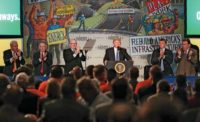Following the November 2008 elections, hope ran high among national union bosses. Unprecedented political canvassing by union members helped shore up a victory for labor-friendly presidential candidate Barack Obama and bolstered the Democrats� headcount on Capitol Hill.
More than a year and a half later, labor leaders have checked several key items off their wish list, as sweeping policy changes have ushered in new opportunities for union contractors across the country. But with the mid-term elections approaching in November, an electorate soured by the lingering recession and soaring unemployment could bring union advances to a halt.
Early on, President Obama sent a message to labor that the tide had turned in Washington. Within weeks of his inauguration he reversed a Bush executive order that banned project labor agreements on federally-funded projects. Stopping short of a mandate, Obama drafted a new order encouraging the use of project labor agreements on projects valued at more than $25 million. Since then, construction unions have been forging PLAs on major work nationwide, including areas that are not traditionally strongholds for organized labor.
Speaking before the Building and Construction Trades 2010 Legislative Conference in Washington, D.C., April 19, Mark Ayers, president of the Building and Construction Trades Department of the AFL-CIO, told members that 21 of 25 major Dept of Energy projects awarded since last summer were under PLA. Government projects in Hawaii, California and Oregon signed in March and April also use PLA, he said.
�And more [are] on the way,� he added.
Still, scoring victories on Capitol Hill can�t cure all of labor�s ills, says Lou Colletti, president of the Building Trades Employers Association in New York City.
�Even though this is a labor-friendly administration, there�s a limit to the amount that can get through even a labor-friendly Congress to help [unions] recapture the strength they once had,� he says. �There are too many unions with competing jurisdictions. Unless they can resolve the problems that exist in their own house, how can they make the changes they need to remain competitive in the marketplace?�
Colletti was a driving force behind the groundbreaking agreement negotiated between the BTEA and the Building and Construction Trades Council of Greater New York last year to help move projects forward that were frozen by the economic downturn. Both sides took wage and benefit cuts and several unions agreed to no strikes or work stoppages on any project included under the pact. The deal is credited with freeing up billions of dollars in projects.
Faith Gavin Kuhn, regulatory affairs and communications director at ABC of Connecticut, expects union members in the northeast to remain highly motivated in light of the recession.
�The division between labor and non-labor is heightened right now because work is so sparse,� she adds. �Labor is really pushing hard.�
Labor�s push has also improved the regulatory environment. The Dept of Labor and Internal Revenue Service have stepped up investigations of independent contractor misclassification in recent months. In April, the Employee Misclassification Prevention Act was introduced in both houses of Congress to address the issue.
The National Labor Relations Board has shifted dramatically as well. A majority of the NLRB is now composed of members with backgrounds in organized labor, including Craig Becker, a former associate general counsel to the AFL-CIO, and Mark Pearce, a labor lawyer and founding partner of Creighton, Pearce, Johnsen & Giroux in Buffalo, N.Y.
�We are certain to see sweeping changes given the composition of the NLRB,� says Geoff Burr, vice president of federal affairs at Associated Builders and Contractors.
Although many items on labor�s political agenda have been addressed, others remain unfinished. After being blocked in the Senate in 2007, the Employee Free Choice Act, dubbed by opponents as �Card Check,� was reintroduced in 2009 but has not moved ahead. Ayers says that the bill doesn�t have enough supporters in Congress to warrant bringing it to a vote, and concedes that he doesn�t think the bill will be move ahead before the November elections.
�[Harry Reid] has said he�ll call for the votes when we have the votes,� he says. �We don�t want anyone to be off the hook because they said they�d vote for it, but it lost.�
The health care bill also yielded mixed results. Although it passed, the final version did not include the Merkley amendment, which would have required construction firms to provide health benefits or pay fines.
Critics argue that the window of opportunity to get those issues through Congress may have shut. Given looming concerns over high unemployment and dissatisfaction among portions of the electorate with passage of the health care bill, it could be tough for Democrats to retain control of both houses after the mid-term elections.
ABC�s Geoff Burr says there is an opportunity for Republicans to pick up approximately 40 seats in the house and seize the majority. New York Sen. Kirsten Gillibrand, who filled the Senate seat vacated by Hillary Clinton in January 2009, is among the Democrats facing a tough election season in November. Gillibrand is a co-sponsor of the Employee Free Choice Act.
However, labor leaders remain optimistic about their chances in November. Sean McGarvey, Secretary-Treasurer of the Building Trades says that if unemployment starts to improve and people better understand the health care bill, public opinion polls could improve for President Obama and congressional leadership.
�People are in for a big surprise when they tally the votes on Election Day and the results are not anywhere near the Armageddon that was predicted,� he says.







Post a comment to this article
Report Abusive Comment